101 BEST PRACTICES >> Administrative IT
Edited By Katherine Grayson
 When it comes to Administrative IT solutions and processes, best
practices run the gamut. Enterprise resource planning (ERP), student
information systems (SIS), and tech support are obvious areas of
focus. But just think about the change that could be accomplished via
the implementation of campuswide document imaging and sharing, a
new approach to RFP writing, or the reassessment of disaster recovery
strategies and tools Never let it be said, however, that the smallest,
seemingly innocuous alteration in practice can’t make a difference:
Even a new user-friendly interface that invites recalcitrant fundraising
officials to actually use their advancement software, or washing
machines that announce from cyberspace that they’re ready to be
unloaded, can dramatically change life on campus as we know it.
When it comes to Administrative IT solutions and processes, best
practices run the gamut. Enterprise resource planning (ERP), student
information systems (SIS), and tech support are obvious areas of
focus. But just think about the change that could be accomplished via
the implementation of campuswide document imaging and sharing, a
new approach to RFP writing, or the reassessment of disaster recovery
strategies and tools Never let it be said, however, that the smallest,
seemingly innocuous alteration in practice can’t make a difference:
Even a new user-friendly interface that invites recalcitrant fundraising
officials to actually use their advancement software, or washing
machines that announce from cyberspace that they’re ready to be
unloaded, can dramatically change life on campus as we know it.
68 :: WANT ADMIN IT DONE RIGHT? DIY
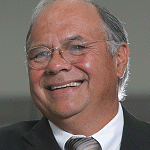
MULTIPLE BEST practices from
San Joaquin Delta's Belarmino.
At San Joaquin Delta College (CA), Lee Belarmino, associate VP of IT, and his peers couldn’t find an
administrative system that worked for them, so they built their own. “We weren’t just interested in the
latest technology for technology’s sake, so we protected our legacy investment in processing on a very
large mainframe Unisys system while we did our research on all the major players in
the administrative world,” Belarmino recalls. “We found the choices extremely pricey for what they were
delivering. So, we developed our own administrative system—almost a full suite: a student information
system, a human resources system, and a payroll system. As the first large-scale administrative system
based on object-oriented development, it took a number of industry awards.” The college also has an
off-the-shelf Oracle financial system.
Belarmino admits that his review of existing products was discouraging, but now other institutions will
benefit, too; see “Partnering for Community Source Financials,” page 49 in our magazine. More info here.
69 :: ‘REAL’ EXPERIENCE FOR PROSPECTS
Franklin & Marshall College (PA) administrators decided
that installing a formal software portal for recruiting wasn’t
worth the expense. But they’ve gotten savvy about using webbased
technology to serve up a personalized experience of the
college. Using Macromedia Flash animations
and streaming video, along with humor, the college tries
to help prospective students feel personally involved with the
school. The most recent innovation is student video blogs, or
vlogs. The concept is risky: Give video cameras to four university
students and let them chronicle what is happening in their
lives, behind the scenes and hanging out in the dorms. “No
scripts, no rehearsals,” the vlog homepage promises. Visitors
can even pick a student tour guide by viewing four video selfintroductions.
Then, as they cruise the campus looking at the
facilities, they can get their tour guide’s impromptu comments.
Dennis Trotter, VP for enrollment at Franklin & Marshall,
calls the approach “experience marketing,” adding, “We try
to use technology to let the personality of the college shine
through.” More info here.
70 :: SELF-RECRUITING = YIELD BOOM
With 40,000-plus unique website visitors each month,
Massachusetts’ North Shore Community College saw an
untapped opportunity to connect with potential students
surfing the college website. The solution was a self-service
eRecruitment system that school administrators developed,
with the following components: 1) A web interface was created
that allows potential students to identify themselves to the
college, access a customized web page with links to resources
that match their interests, and subscribe to the college’s electronic
mailing list. 2) The recruitment component of the college’s
SunGard Higher Education enterprise resource planning (ERP) system was activated
and connected to the web interface. All potential student
information is now captured and transparently passed
through to the ERP system, and potential students are placed
in communication tracks. 3) The college developed an eMarketing
system that allows personalized e-mails to be sent to
target populations. E-mail campaigns are developed and
managed by a communications team, in cooperation with the
college’s Marketing department.
The results: In the first year of operation, more than 5,400
visitors self-recruited and recruit numbers went up more
than 800 percent. A subsequent eMarketing campaign yielded
a 30 percent increase in early enrollments for the fall
semester. Now, all communications are tracked using the
school’s ERP system, which allows the college to make
strategic decisions based on hard data as recruitment efforts
are refined over time.
71 :: BI NEEDS SENIOR-LEVEL CHAMPION

TDWI's Wells on BI
Launching a business intelligence initiative is tough enough
in private industry. But higher ed institutions face some extra
hurdles in rolling out a data warehouse for business intelligence,
according to David Wells, director of education with TDWI, a training and educational
institute for business and IT professionals. Among the
challenges Wells and others cite is that of gathering consensus.
Unlike a typical large business, a university isn’t a single
enterprise, Wells points out. It can be politically difficult if not
impossible to get various entities across campuses to agree on
basic issues, such as what the end-purpose of the data warehouse
is, what data to share, and who should
be in charge. “I think it’s a more challenging
business case to make,”
Wells says, partly because institutions
typically divide immediately
at the top into academic and
administrative sectors. Because a data
warehouse has to integrate across organizational
boundaries, he says, the
arguments that might sell administrators
usually don’t resonate with the academic community, and vice
versa. “It takes a real believer driving from the top to make it
happen.” More info here.
72 :: IT SECURITY ON CAMPUS

DARTMOUTH makes a token effort.
Dartmouth College (NH) has been one of the “early adopters”
of public key infrastructure (PKI) technology among higher ed
institutions. Toward this end, administrators opted to utilize
“tokens”—specifically, eToken technology from Aladdin Knowledge Systems. eTokens include a USBbased
token, a hybrid USB and OTP token, a token with flash
memory, and more. The key-sized tokens simply plug into a USB
port to enable on-board generation and secure storage of keys,
passwords, and certificates for digital signing and encryption.
Dartmouth has issued eTokens for the past two years to all
incoming freshmen, and is planning to issue tokens for all undergraduates
and graduate students within the next two years, as
well as to all faculty, staff, and even alumni. The school had also
considered smart cards for authentication and password management,
but went with USB token devices because smart cards
require readers, and there would have been additional cost and
maintenance compared to the USB ports available on nearly all
computers. The technology is getting less complex and more
affordable, say campus spokespeople.
73 :: LURING STUDENTS BACK TO CLASS
At Colorado Mountain College, administrators are exploring
ways to mine the information in the school’s student information
system (SIS) to turn one-time students into repeat customers.
The school is luring back continuing education students by
informing them about course offerings related to their interests.
“There are a lot of lifelong learner students who take one or
two art courses for personal interest throughout the year,” notes
Bill Sommers, dean of enrollment services. “Through [Datatel’s]
Query Builder and Communications Management, we are informing those students of all art courses
that will be offered in the upcoming semester. This is a great
retention tactic to keep students enrolled each semester.” More info here.
74 :: THAT’S ENTERTAINMENT
For years, the Ohio Northern University network was plagued
with bandwidth problems caused by students downloading and
illegally sharing digital movies and music files. Network performance
tanked, and security problems escalated. In an effort to
stop the bleeding, last year George Gulbis (associate VP and
director of IT) and a small committee set out to find a thirdparty
vendor that could be trusted to manage functions and the
task of managing digital entertainment for the school. The team
found their solution in Ruckus Network, a service offering 1.5 million licensed tracks of music,
thousands of movies, regional and community features, and a
whole lot more.
Before the ink on the contract
had dried, ONU students
were legally downloading
movies and music files
through a password-protected
portal. The portal allows students
to personalize homepages
with movies and music
that interest them. At most
schools, this service
would cost up to $20
per student per semester.
At ONU, however,
school officials agreed to roll
the cost into the annual student
fees. Since the service
went live in spring ’06, ONU
students have downloaded
more than 1 million songs, and
bandwidth performance has improved dramatically. More info here.
75 :: DON’T LET DR DRIVE IT
According to Louisiana State University CIO Brian Voss, the
possibility of natural disaster shouldn’t move an IT chief to take
his eye off the IT ball in favor of disaster recovery. Earlier in
2006, Voss and his peers were completing LSU’s Flagship IT Strategic Plan, and only two of its 10 recommendations
address these survivalist issues. “There are eight
other recommendations,” Voss points out. “They include building
a solid foundation of IT infrastructure, making significant
strides in increasing the accessibility of the campus community
to that infrastructure, developing a robust and multi-tiered
support enterprise, paying attention to our fiscal planning,
developing plentiful resources for research, providing abundant resources to enable faculty teaching and
student learning, supporting the use of
IT in the student living environment,
and developing our own advisory and
communication structures to keep
everything moving forward in a sound
and collaborative way. All these things
are going to be fighting for resources
with the first two, so I’m very concerned
that we are headed into an age in
which CIOs deal only with survival and
are not able to focus on the other broad
elements inherent in our portfolios.” More info here.
76 :: GIVE THEM SELF-HELP TOOLS
Sometimes, the simplest things make all the difference. Every
fall, The University of Akron (OH) support team handles
more than 3,000 wireless setups as the new freshman class
streams in. But according to Matt Bumgard, a member of the
university’s technical support team, there may be another
way. To cut down on the number of cases that require handson
help, UA’s tech support team has created knowledgebase
resources on the campus intranet and flash demos of how to
handle the installations and configurations—all in an effort to
help students connect themselves. If all else fails, there is also
a network card available in the student bookstore for $35 that
is guaranteed to be compatible with the campus wireless network. More info here.
77 :: PERSONALIZE THE PORTAL
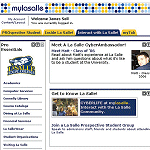
La Salle University’s (PA) portal
Prospective students who venture onto La Salle University’s
(PA) portal are invited to “Ask Dr. Jones.” But this Dr. Jones is
not a fictional dispenser of canned advice, nor a pseudonym
for a back room staffed by admissions counselors. Dr. Nancy
Jones is a real faculty member at La Salle; in fact, she
chairs the Integrated Science, Business, and Technology program.
Jones spends her evenings responding to student e-mails
—one by one. Sometimes she refers technical questions to
other individuals who are experts in areas like housing, financial
aid, or specific academic disciplines. But, often as not, she
follows through and e-mails answers directly to the students—
part of La Salle’s effort to make its online recruiting initiative
personal, not just personalized. “The key is personalization in
a way that teens feel is personal, not the way we feel is personal,”
says Steve Kappler at Stamats, a
higher ed marketing firm. His advice: “Don’t fall in love with
the technology when personalization is what they want.” More info here.
78 :: WATCH THE DRYER
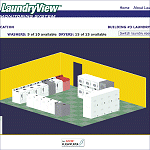
Columbia University's real-time
web-based service - LaundryView.
As of last spring, laundry life at Columbia University (NY)
has changed dramatically. With a real-time web-based service
called LaundryView (from “intelligent” laundry systems vendor
Mac-Gray.), students can log on to the
the LaundryView website from a link off the student information
system (SIS) portal, to see which machines are
free—even before they head to the laundry room. Students
can use their campus debit cards to pay for
the wash, can monitor a load’s progress from the
same web page, and can even program the service
to e-mail them when their load is done. According
to Dave Roberts, director of information services
for the school’s Department of Housing and
Dining, student demand for a more efficient way
to monitor the progress of dormitory laundry
machines sparked the implementation. “On top of
the fact that the service makes laundry easier to
do, there’s a certain wow factor for students that
makes it even better.” More info here.
79 :: 'OPEN SOURCE' YOUR PORTAL
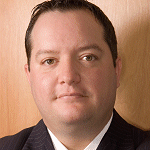
LYNN UNIVERSITY's Christian
Boniforti takes the portal 'open.'
Open source has changed everything about student
computing at Lynn University (FL). In past 9 years, when students wanted to utilize mission-critical systems,
they had to log in to separate systems to access basic functions
(e-mail, course registration, financial aid). They couldn’t toggle
from one app to another, but had to log out of one and log
in to the next. Fed up with the disparate portal sites, CIO
Christian Boniforti set out to centralize all student-oriented
systems within a unique portal, and establish a single sign-on
feature enabling students to access everything they needed. He
opted for uPortal, an open source application
built and designed centrally by JA-SIG (a federation of
higher ed institutions interested in open source.) but maintained locally by Lynn’s IT department.
Taking advantage of the customizable uPortal app, Lynn technologists
created a new school intranet site, MyLynn, combining all student functions within one
easy-to-access portal. Boniforti estimates that by utilizing open
source, the university probably saved up to one-half of what it
would have spent on vendor technology, and the system is so
flexible, he says, his teams have been able to add functions and
features every couple of weeks, always introducing something
new. More info here.
80 :: AID G'ES VIRTUAL
Traditional, brick-and-mortar financial aid offices may soon
be a thing of the past. Now, thanks to an educational financing
option known as the Virtual Financial Aid Office, schools can outsource all or part of their student financial
aid efforts online. The patent-pending service run by Weber and Associates is touted to eliminate
all paper from the financial aid process. On the front end,
students at participating schools sign up, log on, and complete
a financial aid interview. On the back end, the VFAO communicates
with its client school to make sure that the student is
indeed attending, then prepares a financial aid award and originates
a loan with a guarantor or bank.
President Harry Weber explains that the company specializes
in managing Pell Grants, Federal Family Education Loans,
and Federal Direct Loan processing for 30,000-plus students at
more than 130 different institutions in 32 states, Guam, and
Canada. He notes that the biggest benefit to outsourcing financial
aid is cost savings; the VFAO enables schools to save big
bucks on staffing and overhead, though they still must have a
financial aid officer on campus to answer student questions.
This individual has private and secure access to the system so
he can know where a student is in the process at all times. More info here.
81 :: KNOW THY CUSTOMERS’ PAIN POINTS
Chicago’s DePaul University has taken strides to track and
improve service to its students, faculty, and administration
through the use of technology. DePaul’s Information Services
(IS) department was tasked with examining how students
interact with and view various university services. The goal:
Identify solutions that would improve the overall student experience.
The group worked with Touchpoint Associates to create a customized Customer
Experience Management (CEM) model for Higher Education,
designed to help organizations understand their key customer
experiences and identify specific ROI-driven projects. This
model provided the framework for DePaul’s assessment.
The first step was to discover and organize students’
experiences based on the way they prefer to interact with the
university (phone, in-person, web, etc.). Based on the rich
data collected, new solutions were prioritized by the direct
impact on student pain points. In 2006 the university began
work on over 100 new initiatives, including basic process
changes and development of new applications and systems
that support the overall student experience. Solutions have
been as simple as a change in paperwork collection and as
complex as a new online degree audit application that
allows students to track their academic success. The CEM
model is used to inform and shape how the IS group builds
and maintains systems for their internal and external customers
(students, staff, and faculty).
82 :: VIRTUALLY REGISTERED
At Florida Community College at Jacksonville, students
don’t have to leave their dorms to register for classes (a
process that is still arduous at best at many of the nation’s colleges
and universities). Under the direction of Rob Rennie,
FCCJ CIO and winner of a Computerworld IT Leadership
Award, the college (encompassing 24,000 online students and 82 64,000 total students) has created an interactive computer
simulation in which students meet with advisers, register for
classes, and take campus tours via the school’s online portal.
This “virtual campus” incorporates avatars that guide every
student through each process, asking questions and making
recommendations based on each student’s profile. Needless to
say, the kids feel right at home: The simulation is constructed
on the same technology that powers many of today’s popular
video games, allowing students to navigate an environment
that is authentic and familiar. What’s more, FCCJ has effectively
differentiated itself from peer schools and increasingly
popular online universities, while fostering a greater sense of
community among students.
83 :: SNACKIN’ ON THE WEB
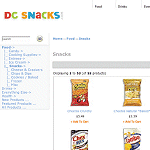
Thanks to DCSnacks.com,
students can order
goodies online.
At George Washington University (DC), the latest
offering in online student services revolves around
pretzels, potato chips, and soda. Thanks to a new
third-party service, DCSnacks.com, students now
have the ability to order their goodies online. This
effort began back in January 2003, when then-GW
student Matthew Mandell launched an online business
enabling students to purchase snack food for
delivery between the hours of 8 p.m. and 2 a.m. on school
nights. At the time, the service met a huge need: None of the
convenience stores on or around campus stayed open that
late. Per student request, the school ironed out a deal with
DCSnacks.com, giving students the capability to pay for
their goodies with Colonial Cash, or the money stored on the
debit strip of their GWorld Card ID cards. Today, students
can log on to the website, order anything from tasty morsels
to reams of printer paper, and pay for the transaction with
their ID cards. When DCsnacks.com employees deliver the
food, the employees check the cards to make sure the user
matches the photo on the card, and upon positive authentication,
they hand over the goods. More info here.
84 :: GOOD IT ADMINISTRATORS SPEAK UP

MIKE YOHE talks.
According to Mike Yohe, executive director of electronic
information services at Valparaiso University (IN), a CIO
worth his salt must intelligently manage the burden of communication,
if IT is to function properly, campuswide. “When
things are going wrong, get out there and say, ‘I know this isn’t
good. Here is what we are doing to fix it, and this is about how
long it is going to take.’” Every Friday, Yohe also pens a
newsletter that is sent to a campus subscriber list. It discusses
what is going right, what is going wrong, what is coming up in
the following week, and what is on the horizon. “I throw in a
few things about how to manage a PC, or other tips,” adds
Yohe. “It runs a couple of typed pages, and it’s written so that
busy people can skim through it, find things they
are interested in, and learn about places to get
more information. It has my ‘voice’ and my
return address. Even the student newspaper
occasionally picks up items from my newsletter.
It also has turned out to be a good way for me
to keep in touch with what is going on in
my own organization.” More info here.
85 :: UNIFORM ACCESS TO INFO, FROM ANYWHERE
In the University of Alaska system, campuses and students are
spread across a geographic area more than three times the size
of Texas. Not surprisingly, the school needed to move a bevy of
mission-critical administrative systems into the online space,
for easier access. At the beginning of the 2003-2004 school
year, officials under the leadership of CIO Steve Smith turned
to SunGard Higher Education for help.
The vendor came back with a $4 million, five-year plan to put
most of the services in the institution’s “administrative core”
into a web-based portal called UAOnline. Next, after a stage of
further enhancements that brought hardware vendor Hewlett-Packard into the mix, Smith and his development
team rebranded the portal as MyUA. The current
iteration of the portal boasts web-based e-mail for students,
as well as access to systems for financial aid,
course registration, and course management. It offers
online applications, the ability to access online transcripts,
and a direct tunnel into the UA library catalogs,
as well. Smith says that the only real challenge thus far
has been in tweaking the portal code so that each individual
campus can add its own colors to the template .More info here.
86 :: TRACK THOSE SHARED ASSETS!
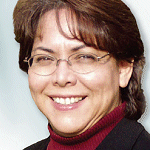
IVONNE BACHAR tracks 'stuff.'
When it comes to the tracking of IT assets—and the
countless dollars saved by watching those equipment
leases, expired software licenses, and the like—a new
wrinkle has emerged: the complexity IT experts foresee
in the tracking of shared assets. According to Stanford University’s (CA) Ivonne Bachar, an authority on asset management
who regularly speaks on the topic and is an instructor
for and past president of the National Property Management
Association, administrators need to look
carefully at all the IT “stuff” they have earmarked for collaborative
efforts, and come up with tracking and management
processes and tools to assist. “As we move more into collaborative
business relationships with other universities, there has
to be a way to track how those assets are
shared, how they are funded, and what
they are authorized to be used for. Often,
Bachar points out, “tracking moveable
equipment is viewed as an administrative
burden. But it can be streamlined.
Managing IT assets, she
states, “can very effectively be a
core business process.” More info here.
87 :: SINGLE-SYSTEM ASSET MANAGEMENT
Most large schools use software for managing large depreciable
assets such as building and air conditioning systems. But
the software they’re already relying on may be able to manage
campus IT assets, as well. Stanford University (CA) had
implemented Sunflower Systems as part of a larger campus overhaul of its financial management
systems. The school (already using the capital assets
management module) is now using the inventory asset management
module, agreement assets module, and IT management
module, as well. According to Ivonne Bachar, director of property
management, because Sunflower interfaces with the
school’s Oracle back-end database and
financials, a single repository of data can now be used for capital
and sponsor-owned, as well as IT, assets. Stanford currently
tracks IT assets and other items, plus the stewardship, accountability,
and transaction history of sponsor-owned, donated,
loaned, and leased equipment. The school also uses its system
for help with replacement planning and the disposition of
assets. Tracking how IT assets are disposed of (with HIPAA
and Sarbanes-Oxley regulations, confidentiality concerns, and
security issues) can be hugely complex, says Bachar.
88 :: THE PERFECT RFP
To locate the best technology solution for your needs, a
request for proposal (RFP) is key, yet it’s amazing how few are
well-crafted. Experts agree that before you add on, every RFP
should contain these six critical sections: 1) The synopsis or
mission statement, which summarizes the technology problem
and the solution required; 2) a list of technical requirements
that outlines mandatory functionalities of a vendor’s solution;
3) the timeline for project completion, including deadlines for
completed RFPs and incremental milestones; 4) a sketch of
budgetary expectations, to give vendors a ballpark idea of
what a school would like to spend; 5) specific information pertaining
to warranties, payment schedules, and other “nittygritty”
details; 6) legalese stipulating that the RFP is a full-
fledged legal document enabling institutions to hold vendors
liable for the solutions they promise therein. No one of these
details is more important than the others, but the most important
thing to remember: Be clear so that a vendor can respond
in a way that you can evaluate. More info here.
89 :: PARTNERING FOR COMMUNITY SOURCE FINANCIALS
Lee Belarmino (associate VP of IT) and his peers at San
Joaquin Delta College (CA) have been instrumental in
the development of Kuali financials, the
first bold step for community source administrative software.
After attending an Open Source Summit (hosted
by rSmart) and a presentation on
Sakai, Belarmino and his colleagues
went to lunch with John Robinson, the founder of
rSmart, and Barry Walsh, director of university information
systems at Indiana University, and Delta now has a sizable
commitment as a founding partner in Kuali: a half million
dollars, between funds and dedicated resources.
The Kuali partners have since completed the first deliverable,
the test drive. “The approach is
service-oriented architecture, where you can tailor the system
to your needs and have the ability to change,” says Belarmino.
“And we’ve eliminated anything proprietary: You can get
everything you need for Kuali development, free. By July ’07
or early ’08, we’ll have a full-fledged financial system, ready to
install.” More info here.
90 :: ENROLLMENT MANAGEMENT MEETS PRIORITIZED CHALLENGES
Schools have all sorts of enrollment management challenges,
and though it’s tempting to look for whiz-bang solutions, the
more prudent (and usually more economical) route is to selfassess
and carefully prioritize need. At the University of
Cincinnati (OH), moving away from a paper prospecting/
recruiting system (and its incumbent costs) was the goal, but
administrators were looking for a system that would enable
them to capture all prospective students in a single database
via uploaded data files, manual data entry from telephone
transactions or inquiry cards, and by students themselves via
the school’s website. Importantly, the technology solution also
had to integrate with the university’s student record system
and keep bounce-backs to a minimum (the SIS was unique to
the university), and so administrators needed detailed tracking
capabilities. They also wanted prospects to receive attractivelooking
e-mails. Finally, customer support was a priority; they
could not afford the system going down.
Administrators chose Hobsons’ EMT Connect, and claim that since they implemented the
solution, average e-mail response rates increased from an “abysmal” 3 percent, to between 20 and 30 percent. And
e-mail communications saved over $100,000 in print production
and postage costs. Clearly, the solution choice was a good
fit, but the university’s methodical needs assessment was key.
91 :: STOP THE SWAP
In an initial wireless network pilot program at Charleston
Southern University (SC), CIO Rusty Bruns discovered
that unforeseen demands were bogging down the network.
“We weren’t prepared for what students were doing in downloading
music and DVDs,” he acknowledged. “We had about
550 users, and just 40 of them ate up the whole bandwidth.”
To address the problem, the school installed Packeteer, an appliance that monitors network
traffic and allows individual access points to be controlled.
File-swapping network activities are restricted, Bruns adds.
“In the beginning, I was seen as the bad guy because I
wouldn’t let students trade music. But in the long run, none
of our students got busted for illegal swapping, so I turned
out to be a pretty good guy.” More info here.
92 :: OPEN SOURCE SIS: GETTING BUY-IN
San Joaquin Delta College (CA) Associate VP of IT Lee
Belarmino thinks a community source student information
system (SIS) is of paramount importance. “We believe this
is the Big One, and [a system] we are anxious to [help create
and implement]. We’ve had a number of meetings with the
other interested schools about whether it’s feasible to build
an SIS in pure service-oriented architecture and what kind
of attention it would attract. Responses were quite positive.
Plus, we’ve identified vendors who may be willing to partner
with us on open source code, so we won’t be starting
from scratch. But without question, Delta will be part of this
next initiative.” How important to such a huge undertaking
is presidential buy-in and pan-campus teamwork? And what
part of such an effort is supported by know-how, what part
by belief in what you’re doing? “My president and I have a
great partnership,” Belarmino asserts, “and our team at the
college is so good; they’re the ones making this happen. How
much we believe in [open source] is a passion. We all believe
that we’re onto something big. More info here.
93 :: DATA MINING FOR ACADEMIC SUCCESS
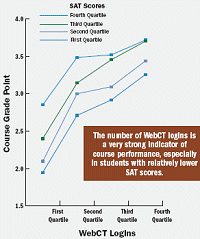
INDICATORS OF SUCCESS
WebCT Logins and SAT
Scores Relative to GPA
Researchers at Purdue University (IN) are developing models
to predict academic success: academic analytics that will
eventually be used to create interventions for at-risk students.
Their first step was to identify data that could be mined
from the course management system (CMS) and from the
student information system (SIS), and demonstrate which
factors are most significant. Researchers studied an initial
sample of about 1,500 students during the fall ’05 semester,
and quickly expanded their work to reflect the entire range
of WebCT-supported (blackboard.com) classes at
Purdue in spring ’06. Analyses now include data on
some 130,000 seats in the CMS, representing more
than 30,000 students.
The researchers are rigorously examining indicators of
aptitude and effort, by mining historical data such as SAT
scores and GPA from the SIS (reflecting aptitude), and data on
student use of the CMS from the Oracle back-end database connected to their WebCT system (reflecting
effort). Ultimately, the end goals are to develop intelligent
agents that will automatically take actions (such as alerting the
instructor that a student is likely in trouble, or notifying the
student about help sessions that are available), and to provide
trend data to administrators with an interest in retention. More info here.
94 :: SUBJECT-MATTER EXPERTS FOR DATA WAREHOUSING
Key to building a data warehouse is bridging the longstanding
gap between IT and business. More so than with
many other technology solutions to business problems, data
warehousing tests the bridges between IT and the rest of the
campus. At the University of Illinois, for instance, the
bridge between IT and business is largely handled by three
“functional area coordinators.” These subject-matter experts focus on three key data areas: students, finance, and human
resources. They act as liaisons between their areas of specialty
and the data warehousing team. According to Aaron
Walz, business architect for the Decision Support team,
these individuals “translate what the customers are saying,
putting that into a language that the technical staff can
understand.” Yes, any significant IT initiative needs the
business side of the house on board. But in such a case, IT
really needs to understand what questions the business side
needs to ask—and at a much higher level, because today,
schools are looking to analytics. That means that the
people who know how to produce reports—often highly
technical IT staff within the DW group—need a deep
and broad understanding of what drives the institute. More info here.
95 :: INSTITUTION, ASSESS THYSELF

HOMEGROWN: Texas
A&M assesses first for
improved performance.
In the past, staffers at most schools carried out many assessment
functions by hand. Nowadays, however, a growing number
of schools are embracing data-driven web-based interfaces
and new data analysis techniques to ease the process. Schools
such as Texas A&M University, the University of Central
Florida, the University of California-Davis, Western
Washington University, and Flagler College (FL) are utilizing
new advances in institutional assessment tools in
order to improve performance across the board. Some have
turned to vendors such as Jenzabar and
SunGard Higher Education for help.
Yet, interestingly, many notable advancements in institutional
assessment are proprietary. At Texas A&M, for
instance, technologists have developed a homegrown database,
based on Microsoft Access, to
chart institutional performance by keeping tabs on what’s
happening with faculty members. The database, which users
can access from a web-based interface, tracks various stats
about faculty productivity for publishing, grants, awards,
editorships, classes taught, and graduate students completed.
University administrators utilize data from the program
to evaluate individual programs, certain clusters of departments,
and sometimes even the school as a whole. More info here.
96 :: CONSIDER ADMIN IT BY CONSORTIUM
Thinking about power in numbers? TheWisconsin Association
of Independent Colleges and Universities is currently engaged in a six-year process to perform
the administrative support functions of its 20 members
on a collaborative basis. The object: to control institutional
costs. Three members of WAICU (Lakeland College, Ripon
College, and Wisconsin Lutheran College), with different
constituencies and business processes, created the WAICU
Educational Technology Consortium to purchase, implement,
and support a common administrative system (provided by
Jenzabar, via a fixed-price, not-to-exceed
contract). The Milwaukee School of Engineering joined the
consortium in May 2006. To date, the following savings have
been realized on a per-school basis: software (80 percent),
maintenance (40 percent); MS'E saved nearly $1 million
over 10 years on maintenance costs alone. The first three
schools went live in just 10 months instead of the usual 18.
And by collaborating, the schools have also saved on implementation
travel-related expenses and training, and have
pooled resources, knowledge-sharing, and user group opportunities.
All of this has resulted in increased buying power
for future projects.
97 :: DW SUCCESS: MARKET THE RAISON D’ETRE
Part of the data warehouse challenge is the constant effort
to explain its usefulness to users. “‘Build it and they will
come’ is a very ugly myth,” says Aaron Walz, business architect
for the Decision Support team at the University of Illinois.
When the university erected its new systemwide
enterprise resource planning (ERP) structure, some of the
standard mainframe reports were duplicated, but not all. Even
so, Walz says, users “still had to be convinced that coming to
the warehouse was worth their time and that they needed it.
You have to provide something that is very targeted to what
they’re trying to do, so they can see that it’s helpful.”
His group puts ongoing effort into promoting the warehouse,
including training sessions and periodic messages to
everyone with a warehouse account, encouraging them to
use it. The Decision Support team also analyzes who’s using
the warehouse and how, and uses that information to drive
marketing efforts. “We also make presentations to different
groups on campus, such as human resources and business
managers. We tell them, ‘Hey, here’s what you can do with
the data warehouse.’” Walz says. “If it takes too much time,
or if it’s too complicated to get access, they just don’t use
it.” More info here.
98 :: MORE DW HELP: ASK THE RIGHT QUESTIONS
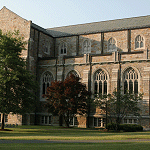
RPI CAN NOW slice, dice, and track.
One way that Rensselaer Polytechnic Institute
(NY) uses its data warehouse is to track
admissions closely by answering questions
like: “Are we attracting the types of students
we want? How well are we translating student
inquiries into applications? How about
converting those applications into admitting
students?” When a new strategy for attracting
students was introduced recently, the
results were immediately available on a
daily basis from the data warehouse via analytic
dashboards. What’s more, because
Rensselaer is a large research university, it
finds the data warehouse useful for monitoring
research, with questions like: “Where,
exactly, is our research money coming from? Who’s performing
the research—are they working through the university
or the research center?” Unlike in the past (before new
data warehousing systems and processes were put into
place), “It’s very easy now to slice and dice, and everyone
agrees on the numbers,” says RPI Data Warehouse Program
Manager Ora Fish. More info here.
99 :: SCALING UP TO PAPERLESS FOR DISASTER RECOVERY PLANNING
At Pittsburgh State University (KS), a document imaging
system, now deployed in 17 departments in two campus
locations and including some 1.1 million documents, is
helping to streamline processes, cut back paper-based storage,
and even address disaster recovery planning issues.
Using Perceptive Software’s ImageNow document management, imaging, and workflow software,
university staff have single-click access to documents
from either campus location. The system is managed by an
administrative team at PSU that has employed a staged
implementation strategy that began with just three departments—
financial aid, undergraduate admissions, and the
registrar—and allows a cost-effective expansion to a campuswide
solution.
And at Tulane University in New Orleans, where administrators
would have to wade through student records for 11
colleges in the event of another disaster, the institution has
deployed an enterprise content management (ECM) solution
from Digitech Systems. The system
has enabled administrators to cut the standard three-day
information access time by 66 percent, has allowed the university
to regain 160 man-hours per month, has enabled vastly
improved customer service, and has greatly boosted disaster
preparedness. Three layers of application security ensure that
users are only granted appropriate access to allowed functionality
and data.
100 :: THE COMMUNITY SOURCE EXPERIENCE
Lee Belarmino, San Joaquin Delta College (CA) associate
VP of IT, on the Kuali (community source financials) partnership experience: “Initially, we thought we
might get swallowed up by the large universities involved
[with the Kuali project]. But it’s clear to us now that it’s a
level playing field. What’s important are your ideas, your
ability to produce, and how you get along with the community.
Another good thing,” he adds: “We’ve found that Kuali is
totally driven by the functional people. They decide how the
system should operate and behave, and the developers have to
come through. We’ve completed our first deliverable, which
is our test drive.” More info here.
101 :: POWER UP EVEN A TINY ADVANCEMENT OFFICE
Sometimes, improved revenue streams can be realized by
empowering even the smallest college or university department.
At Union University (TN), the Advancement office
was being held back by an outmoded legacy system, but
administrators were concerned about transitioning the small
(yet all-important) group of fundraising staffers to a new,
more sophisticated system. The hardware platform was due
to be discontinued, so administrators decided to take the
opportunity to evaluate other software solutions; they went
with Datatel’s Colleague Advancement, which offered the cleanest user interface.
“Our legacy system was not very user-friendly and the
development officers had never been able or willing to learn
the system,” says Director of Computing Services Karen
McWherter; “A more user-friendly interface would help
them to do their own data entry and information lookup.
With the web user interface of the new system, they are
going to be able to do that. We have a very small Advancement
department, so getting everyone involved in using the
software will make them all more effective.”

